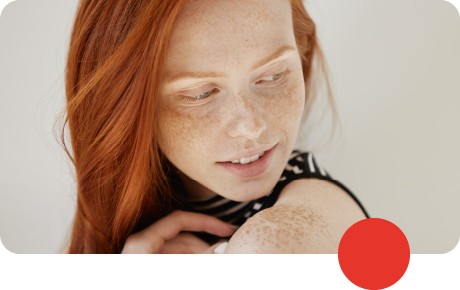The topics and descriptions discussed within this document are general in nature. These general discussions are not intended and should not be interpreted to make recommendations or claims regarding the use, efficacy or safety of products, formulas or vehicles. Only a physician or other appropriately licensed professional, as a learned intermediary, can determine if a formula, product or service is appropriate.
The matters discussed herein are for informational purposes only and not intended for the purpose of providing legal advice. You should consult your attorney in case of any questions as to when it is appropriate to compound or regarding any other particular issue discussed or referenced in this document.
1. Handel A, Miot L, Miot H. Melasma: a clinical and epidemiological review. An Bras Dermatol. 2014; 89(5): 771-782.
2. Ogbechie-Godec O, Elbuluk N. Melasma: an Up-to-Date Comprehensive Review. Dermatol Ther (Heidelb). 2017; 7(3): 305-318.
3. Addor F. Antioxidants in dermatology. An Bras Dermatol. 2017: 92(3): 356-362.
4. Monteiro R, Kishore B, Bhat R, Sukumar D, Maris J, Ganesh H. A comprehensive study of the efficacy of 4% hydroquinone vs 0.75% kojic acid cream in the treatment of facial melasma. Indian J Dermatol. 2013;58(2):157.
5. Jimbow K, Obata H, Pathak M, Fitzpatrick T. Mechanism of depigmentation by hydroquinone. Journal of Investigative Dermatology. 1972; 62(4): 436-449.
6. Bandyopadhyay D. Topical treatment of melasma. Indian J Dermatol. 2009; 54(4): 303-309.
7. Griffiths C, Finkel L, Ditre C, Hamilton T, Ellis C, Voorhees J. Topical tretinoin (retinoic acid) improves melasma. A vehicle-controlled, clinical trial. Br J Dermatol. 1993; 129(4):415-21.
8. Torok H. A comprehensive review of the long-term and short-term treatment of melasma with a triple combination cream. Am J Clin Dermatol. 2006; 7(4): 223-30.
9. Torok H, Taylor S, Baumann L. A large 12-month extension study of an 8-week trial to evaluate the safety and efficacy of triple combination (TC) cream in melasma patients previously treated with TC cream or one of its dyads. J Drugs Dermatol. 2005; 4(5): 592-7.
10. Gupta AK, Gover MD, Nouri K, Taylor S. The treatment of melasma: a review of clinical trials. J Am Acad Dermatol. 2006; 55(6): 1048-65.
11. Bala H, Lee S, Wong C, Pandya AG, Rodrigues M. Oral tranexamic acid for the treatment of melasma: a review. Dermatol Surg. 2018; 44(6):814-825.
12. Atefi N, Dalvand B, Ghassemi M, Mehran G, Heydarian A. Therapeutic effects of topical tranexamic acid in comparison with hydroquinone in treatment of women with melasma. Dermatol Ther. 2017; 7(3): 417-424.
13. Navarrete-Solis J, Castanedo-Cazares J, Torres-Alvarez B. A double-blind, randomized clinical trial of niacinamide 4% versus hydroquinone 4% in the treatment of melasma. Dermatol Res Pract. 2011. Doi 10.1155/2011/379173.
14. Sarkar R, Arora P, Garg K. Cosmeceuticals for hyperpigmentation: What is Available?. J Cutan Aesthet Surg. 2013; 6(1):4-11.
15. Espinal-Perez LE, Moncada B, Castanedo-Cazares JP. A double-blind randomized trial of 5% ascorbic acid vs. 4% hydroquinone in melasma. Int J Dermatol. 2004;43(8):604–607.
16. Al-Niaimi F, Chiang N. Topical vitamin C and the skin: Mechanisms of action and clinical applications. J Clin Aesthet Dermatol. 2017; 10(7): 14-17
17. Balina L, Graupe K. The treatment of melasma. 20% azelaic acid versus 4% hydroquinone cream. Int J Dermatol. 1991;30(12):893-5.
18. Verallo-Rowell V. Verallo V, Graupe K. Lopez-Villafuerte L, Garcia-Lopez M. Double-blind comparison of azelaic acid and hydroquinone in the treatment of melasma. Acta Derm Venereol Suppl. 1989; 143: 58-61.
19. Sarkar R, Bansal S, Garg V. Chemical peels for melasma in dark-skinned patients. J Cutan Aesthet Surg. 2012; 5(4): 247-253.
20. Lim J. Treatment of melasma using kojic acid ina gel containing hydroquinone and glycolic acid. Dermatol Surg. 1999; 25(4): 282-4
21. Bissett D, Robinson L, Raleigh P. Reduction in the appearance of facial hyperpigmentation by topical N-acetyl glucosamine. J Cosmet Dermatol. 2007; 6(1):20-6


